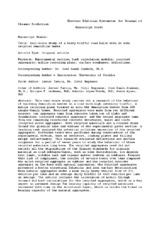Mostrar el registro sencillo del ítem
Real-scale study of a heavy traffic road built with in situ recycled demolition waste
| dc.contributor.author | Tavira, Javier | |
| dc.contributor.author | Jiménez, José Ramón | |
| dc.contributor.author | Fernández Ledesma, Enrique | |
| dc.contributor.author | López Uceda, Antonio | |
| dc.contributor.author | Ayuso Muñoz, Jesús | |
| dc.date.accessioned | 2024-02-07T11:30:27Z | |
| dc.date.available | 2024-02-07T11:30:27Z | |
| dc.date.issued | 2020 | |
| dc.identifier.issn | 0959-6526 | |
| dc.identifier.uri | http://hdl.handle.net/10396/27230 | |
| dc.description.abstract | This real-scale study carries out a research of the behaviour of building demolition wastes in a road with high intensity traffic. A mobile recycling plant treated in situ the demolition wastes from 105 single-family homes. Recycled aggregates were made from two different sources: one aggregate came from concrete taken out of slabs and foundations (recycled concrete aggregate) and the second aggregate came from the remaining reinforced concrete structures, walls and roofs (recycled mixed aggregate). Both recycled materials and a crushed stone formed the granular base and subbase of the experimental paved section. A leaching test analysed the potential pollutant emissions of the recycled aggregates. Different tests were performed during construction of the experimental section, such as densities, loading plates and falling weight deflectometry. This research evaluated deflections and surface roughness for a period of seven years to study the behaviour of these recycled materials long term. The recycled aggregates used did not satisfy all the stipulations of the Spanish standards for granular material as road subbases/bases, such as size distribution, Los Angeles test limit, soluble salt and organic matter content in subbases. Despite this lack of compliance, the results of on-site tests over time compared the mixed recycled aggregate as subbase and the recycled concrete aggregate as the base with natural aggregates; the recycled aggregates presented a better structural behaviour and less surface deterioration than natural aggregates under a mean daily heavy vehicle flow of 371 vehicles per lane and an average daily traffic of 4469 vehicles per lane on average. The article includes the calculation of moduli through forward and back calculations for the recycled aggregates, which is a key aspect in pavement design The bearing capacity of recycled materials increased with time in the structural layer, which is unlike the trend in bearing capacity of the natural aggregates. | es_ES |
| dc.format.mimetype | application/pdf | es_ES |
| dc.language.iso | eng | es_ES |
| dc.publisher | Elsevier | es_ES |
| dc.rights | https://creativecommons.org/licenses/by-nc-nd/4.0/ | es_ES |
| dc.source | Tavira, J., Jiménez, J. R., Ledesma, E. F., López-Uceda, A., & Ayuso, J. (2020). Real-scale study of a heavy traffic road built with in situ recycled demolition waste. Journal of Cleaner Production, 248, 119219. https://doi.org/10.1016/j.jclepro.2019.119219 | es_ES |
| dc.subject | Experimental section | es_ES |
| dc.subject | Back calculation modulus | es_ES |
| dc.subject | Recycled aggregates | es_ES |
| dc.subject | Mobile recycling plant | es_ES |
| dc.subject | Surface roughness | es_ES |
| dc.subject | Deflections | es_ES |
| dc.title | Real-scale study of a heavy traffic road built with in situ recycled demolition waste | es_ES |
| dc.type | info:eu-repo/semantics/article | es_ES |
| dc.relation.publisherversion | https://doi.org/10.1016/j.jclepro.2019.119219 | es_ES |
| dc.rights.accessRights | info:eu-repo/semantics/openAccess | es_ES |

